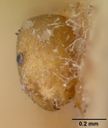Pharaoh Ant
Monomorium pharaonis
Classification
- Phylum: Arthropoda
- Subphylum: Hexapoda
- Class: Insecta
- Order: Hymenoptera
- Superfamily: Formicoidea
- Family: Formicidae
- Subfamily: Myrmicinae
- Tribe: Solenopsidini
- Genus: Monomorium
- Species: pharaonis
Pronunciation
How to pronounce Monomorium pharaonis: //ˌmɒnoʊˈmɔːriəm ˌfɛrəˈoʊnɪs//
These audio files are automatically generated. While they are not always 100% accurate, they are a good starting point.
Images






Summary
Monomorium pharaonis, commonly known as the Pharaoh ant, is a small, yellow to light brown ant notorious for being a pervasive indoor pest. Originating from Africa, it now exists globally, primarily thriving in buildings due to its ability to adapt. Known for its high reproductive capacity and unique budding behavior, this ant species successfully forms multiple colonies, complicating extermination efforts.
Physical Characteristics
Pharaoh ant workers are about 1.5–2.0 mm long, light yellow to reddish brown in color with a darker abdomen. Males are about 3 mm long, black and winged (but do not fly). Queens are dark red and measure 3.6–5.0 mm long. Their petiole has two nodes and their thorax has no spines. They possess a non-functional stinger and poor eyesight with an average of 32 ommatidia.
Identification Tips
Look for small (2 mm), yellow or light brown ants with a distinct two-node petiole, darker abdomen, and poor eyesight. Queens are larger, dark red, and shed their wings shortly after mating.
Habitat
Pharaoh ants thrive in a variety of indoor environments, especially where central heating is present, and do not typically nest outdoors except in southern latitudes.
Distribution
Introduced to virtually every area of the world, including Europe, the Americas, Australasia, and Southeast Asia. They have a spotty distribution across the United States but can reach high densities in localized areas.
Diet
Pharaoh ants have a diverse diet, feeding on grease, sugary foods, and dead insects. They exhibit preferences for different food types based on satiation and may alternate between carbohydrate-rich and protein-rich foods.
Life Cycle
The life cycle includes an egg stage, larval period, pre-pupal stage, pupal stage, and adult stage. Eggs hatch in 5 to 7 days, and it takes about 38 to 45 days from egg to sexual maturity. Colonies breed continuously in heated buildings throughout the year.
Reproduction
Mating occurs within the nest with males usually from other colonies to ensure genetic diversity. Queens can lay up to 400 eggs following mating. Colonies are polygynous, containing multiple queens that can lead to high reproductive potential.
Ecosystem Role
As an invasive species, Pharaoh ants can affect local ecosystems by displacing native ant species and competing for food resources. They are major indoor pests.
Economic Impact
Pharaoh ants are notorious indoor nuisances, especially in hospitals and food service environments. Their presence can lead to increased pest control costs and can compromise sanitation standards.
Cultural Significance
The common name 'pharaoh ant' is thought to derive from the mistaken belief that this species was one of the plagues of Egypt.
Collecting Methods
- Using bait traps
- Sticky traps
- Vacuum collection
Preservation Methods
- Ethanol preservation
- Drying specimens
- Freezing for a short period
Evolution
Pharaoh ants are thought to be a cryptogenic species that has adapted to human environments, demonstrating flexible social structures and efficient foraging strategies that aid in their invasiveness.
Misconceptions
Pharaoh ants are often confused with other small ant species; however, their polygynous nature and pheromone communication set them apart.
Tags
- invasive species
- pest control
- ant behavior
- social insects
- hospital pest